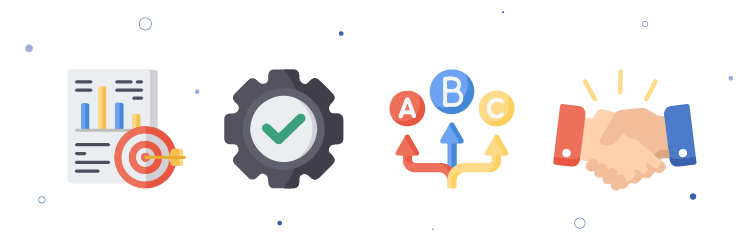Learn all about a Single Source of Truth: what it is, the benefits and how to implement it.
You can hardly open a news website without seeing articles about organizations growing and innovating thanks to data or new laws regulating or restricting data use. In today's digital world, data is an essential element that is rapidly evolving. However, with a vast amount of data spread across different sources and systems, it’s becoming increasingly challenging for companies to determine which data is reliable and actionable.
Organizations often face challenges when different departments use varying versions of ‘truths,’ leading to a lack of oversight and consistency of their data. This can be a source of stress and confusion. However, to solve this issue, organizations can implement a Single Source of Truth (SSOT), which creates a central location where all relevant customer data is stored, managed, and accessed by everyone.
This article covers the essential details about a Single Source of Truth (SSOT). We explain a SSOT, its advantages, and the necessary steps to create one effectively. By the end of the article, you'll clearly understand the critical factors to ensure a successful SSOT implementation.
The term itself is self-explanatory: SSOT is a single, central source of truth. It’s where an organization stores critical data, such as customer information, product details, financial data, and marketing results. The purpose of SSOT is to consolidate data in one place, enabling everyone to access the most up-to-date information, which prevents confusion and ensures informed decisions. It also helps with compliance.
Pieter Hallewas, the director at Invenna and Human Inference, explains: “Companies often face issues when different departments use different systems, leading to different interpretations of data. Sometimes, outdated data or data that no longer complies with AVG regulations are used. However, with SSOT, companies can get a complete and accurate picture of their customers. This ensures they always have the right information and comply with regulations.”

Understanding your customers is vital for success, regardless of your industry. Whether you are a part of an energy supplier or a charity, it’s essential to have the necessary insights to communicate effectively with your customers. A single source of truth (SSOT) can provide you with the required information to establish stronger relationships with your customers by allowing you to communicate more relevantly with them.

Now that you understand the significance of having a Single Source of Truth (SSOT) for your business, you might be interested in knowing how to develop one. Creating a SSOT can be highly beneficial but requires a systematic approach.
To begin with, it’s crucial to identify the data sources and determine which ones are most valuable for your business. This includes analyzing the systems you use, such as CRM and ERP, and the data, such as customer information and website data. It’s also essential to clearly understand where your data comes from, what you store, and how you manage it.
After identifying the data sources you wish to utilize, the next step is standardizing the data. This involves ensuring that the data is complete, accurate, free from duplicates, consistent and valid. Once the data has been standardized, it can be migrated to a centralized database or platform.
It's essential to link all your data sources together to migrate smoothly, mainly because your data will likely be scattered across various systems. You can leverage technologies such as a Customer Data Platform (CDP), data lakes, or Master Data Management (MDM) to link your data sources. These technologies help you collect, aggregate, store, and analyze large amounts of data quickly and efficiently.
A well-defined data management strategy is crucial to maintaining the accuracy and currency of your data. This involves setting up a data governance system and implementing guidelines for data management. You should appoint data owners, establish quality standards for your data, perform regular audits, and educate your team about the significance of maintaining precise data.

Learn how to create a Single Source of Truth (SSOT) today. We are here to assist you in:
• Analyzing your data infrastructure.
• Creating a SSOT roadmap.
• Selecting the right technologies.
• Training your team in data management.
It's crucial to continuously monitor and improve your SSOT as your data landscape evolves.
Here are a few tips to get you going:

Mediahuis, the group behind well-known titles such as Gazet van Antwerpen and Telegraaf, recognizes the importance of reliable data. However, with over 30 news brands across five countries, managing vast amounts of data and creating a Single Source of Truth (SSOT) was challenging.
Through our Customer Data Platform, we brought all the data together and provided Mediahuis with a complete picture of their customers. The results?

Read the case and see how they use the power of data with a SSOT to put customers first!
In today's data-driven world, many organizations struggle to manage their often scattered data. The solution to this problem is implementing a Single Source of Truth (SSOT), which involves having a central location to manage, share, and store all critical data.
A SSOT provides a strong foundation for decision-making and improves organizations' efficiency, accuracy, and compliance. However, setting up a SSOT requires a structured approach, which includes identifying and standardizing data, using appropriate technologies, and implementing good information management practices.
To get the most out of their SSOT, organizations should encourage engagement, clear goals, and simple processes. A great example is Mediahuis's success story, where an SSOT facilitated personalized marketing, a streamlined data landscape, and millions of customer interactions.

Unlock your organization's potential with a SSOT today. Contact us now to learn how we can help you create a reliable and consistent foundation.
A Customer Data Platform (CDP) collects, integrates, and analyzes customer data from multiple sources, creating a comprehensive 360-degree view of your customers. This enables you to gain deeper insights and enhance their experience, ultimately maximizing your return on investment.
Contact us for a brief introductory discussion on how to harness the power of your customer data. No obligations, just valuable insights!
Unlock the potential of your customer data with our customer value guide! Discover a practical four-step plan to enhance your services and boost customer loyalty.
Leave your details to download your free customer value guide now!
With our data platform technology we are going above and beyond: you organize thousands of (marketing) actions, create analyses, complete missing information and control and monitor all customer data. And these are merely examples.
Discover how we make your organization data-driven and what you achieve with the unique customer view. Tell us more about yourself and we'll contact you soon.
The Invenna platforms are suited for small and large companies. For marketing, analytics, compliance and IT. And for diverse industries such as autmotive and charity.
Because of the numerous options and organization's individual needs and wishes, we'd like to show you what you can do and achieve with our platforms. Leave your details and we'll contact you to schedule a (digital) demo. Free and without strings attached.
In the brochure you read what the Invenna Customer Data Platform offers you and the benefits of working with a unique customer view. And to get you started, we also share a few use cases.
Leave your details and we'll send you the brochure via email.
Whether you’re looking to improve your operational processes or gain a quicker response to marketing and sales activities: the Customer Data Platform helps to achieve goals.
Get in touch with us and we’ll tell you more about merging all your customer data into a unique customer view. And equally important: what you achieve with the platform.
In the brochure you read what the Invenna Customer Data Platform offers you and the benefits of working with a unique customer view. And to get you started, we also share a few use cases.
Leave your details and we'll send you the brochure via email.
The possibilities of the Invenna Customer Data Platform B2C are limitless. Because of organization's individual needs and wishes, we'd like to show you our platform and its features so you get an idea of how it helps to achieve your goals.
Leave your details and we'll contact you to schedule a (digital) demo. Free and without strings attached.
In the brochure you read what the Invenna Customer Data Platform offers you and the benefits of working with a unique customer view. And to get you started, we also share a few use cases.
Leave your details and we'll send you the brochure via email.
Whether you’re looking to improve your operational processes or gain a quicker response to marketing and sales activities: the Customer Data Platform for B2B helps to achieve goals.
Get in touch with us and we’ll tell you more about merging all your customer data into the unique customer view and how you can benefit from the platform.
In the brochure you read what the Invenna Customer Data Platform offers you and the benefits of working with a unique customer view. And to get you started, we also share a few use cases.
Leave your details and we'll send you the brochure via email.
The possibilities of the Invenna Customer Data Platform B2B are limitless. Because of organization's individual needs and wishes, we'd like to show you our platform and its features so you get an idea of how it helps to achieve your goals.
Leave your details and we'll contact you to schedule a (digital) demo. Free and without strings attached.
In the brochure you read what the Invenna KYC platform offers you and the benefits of working with a unique and complete customer view. And for inspiration, we also share extra content.
Leave your details and we'll send you the brochure via email.
Whether you’re looking to improve your operational processes or respond more swiftly to potential risks: the KYC platform helps to achieve goals.
Get in touch with us and we’ll tell you more about merging all your customer and transaction data into the unique customer view.
The possibilities of the Invenna KYC platform are limitless. Because of organization's individual needs and wishes, we'd like to show you our platform and its features so you get an idea of how it helps to achieve your goals.
Leave your details and we'll contact you to schedule a (digital) demo. Free and without strings attached.
In the brochure you read what the Invenna KYC platform offers you and the benefits of working with a unique and complete customer view. And for inspiration, we also share extra content.
Leave your details and we'll send you the brochure via email.
We work with and for over 75 of The Netherlands’s finest brands every day. From Mediahuis and Nissan to the Tax and Customs Administration and Dutch police. So we've grown considerably, but still don't shy away from any customer data challenge.
Would you like to know more about is? Or are you wondering how we make your organization more data-driven? Tell us more about yourself and we'll contact you soon.